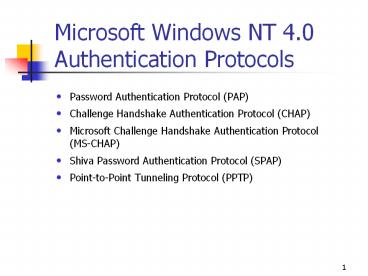Microsoft Windows NT 4.0 Authentication Protocols - PowerPoint PPT Presentation
Title:
Microsoft Windows NT 4.0 Authentication Protocols
Description:
Microsoft Challenge Handshake Authentication Protocol (MS-CHAP) Shiva Password Authentication Protocol (SPAP) Point-to-Point Tunneling Protocol (PPTP) ... – PowerPoint PPT presentation
Number of Views:276
Avg rating:3.0/5.0
Title: Microsoft Windows NT 4.0 Authentication Protocols
1
Microsoft Windows NT 4.0 Authentication Protocols
- Password Authentication Protocol (PAP)
- Challenge Handshake Authentication Protocol
(CHAP) - Microsoft Challenge Handshake Authentication
Protocol (MS-CHAP) - Shiva Password Authentication Protocol (SPAP)
- Point-to-Point Tunneling Protocol (PPTP)
2
Microsoft Windows 2000 Authentication Protocols
- Support the Windows NT 4.0 authentication
protocols - Extensible Authentication Protocol (EAP)
- Remote Authentication Dial-In User Service
(RADIUS) - Internet Protocol Security (IPSec)
- Layer Two Tunneling Protocol (L2TP)
- Bandwidth Allocation Protocol (BAP)
3
Extensible Authentication Protocol (EAP)
- Is an extension to the Point-to-Point protocol
(PPP) - Works with dial-up, PPTP, and L2TP clients
- Allows arbitrary authentication mechanisms to
validate a dial-in connection - Supports authentication by using generic token
cards, MD5-CHAP, and TLS - Allows vendors to supply new client and server
authentication modules
4
Remote Authentication Dial-In User Service
(RADIUS)
- RADIUS provides
- Remote user authentication that is
vendor-independent. - Scaleable authentication designs for performance.
- Fault-tolerant designs for reliability.
- Windows 2000 can act as a RADIUS client or server.
5
Windows 2000 Can Act as a RADIUS Client
- A RADIUS client
- Is typically an ISP dial-up server
- Receives authentication requests
- Forwards the requests to a RADIUS server
- A Windows 2000 RADIUS client
- Can also forward accounting information
- Is configured on the remote access servers
Securities tab
6
Windows 2000 Can Act as a RADIUS Server
- A RADIUS server validates the RADIUS client
request. - Windows 2000 uses Internet Authentication
Services (IAS) to perform authentication. - IAS stores accounting information from RADIUS
clients in log files. - IAS is one of the optional components you can add.
7
Internet Protocol Security (IPSec)
- Consists of a set of security protocols and
cryptographic protection services - Ensures secure private communications over IP
networks - Provides aggressive protection against private
network and Internet attacks - Negotiates a security association (SA) with
clients that acts as a private key to encrypt the
data flow
8
Layer Two Tunneling Protocol
- Similar to PPTP
- Creates an encrypted tunnel
- Does not provide encryption
- Works with encryption technologies such as IPSec
9
Differences Between L2TP and PPTP
- L2TP does not require an IP-based transit
network. - L2TP supports header compression.
- L2TP supports tunnel authentication.
- L2TP uses IPSec for encryption and PPTP uses PPP
encryption.
10
Bandwidth Allocation Protocol (BAP) and Bandwidth
Allocation Control Protocol (BACP)
- Dynamically add or drop links on demand
- Are PPP control protocols
- Provide bandwidth on demand
10
11
Allowing Inbound Dial-Up Connections
12
Configuring Devices for Incoming Connections
13
Allowing Virtual Private Connections
- Click Next on the Devices For Incoming
Connections page. - Select either to allow or not allow virtual
private connections on the Incoming Virtual
Private Connection page.
14
Specifying Users and Callback Options
15
Selecting Networking Components
- Choose the networking components to enable for
incoming calls. - Install additional networking components.
16
Dial-Up Connections
17
Connections to a Virtual Private Network (VPN)
- Create a VPN by using tunneling protocols such as
PPTP or L2TP. - Create secure connections across an untrusted
network. - Select Connect To A Private Network Through The
Internet. - Decide if you want to select Automatically Dial
This Initial Connection. - Enter the host name or IP address to which you
are connecting. - Specify who can use the connection.
18
Direct Connection to Another Computer Through a
Cable
- Select Connect Directly To Another Computer.
- Select whether your computer will be the host or
the guest for the connection. - Select the port that is connected to the other
computer. - Specify the users who can use this connection.
- Decide if you want a shortcut icon on your
desktop.































